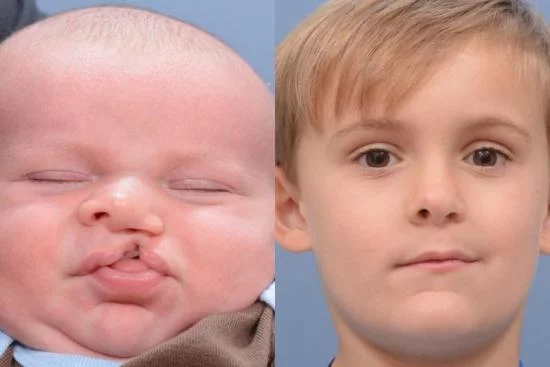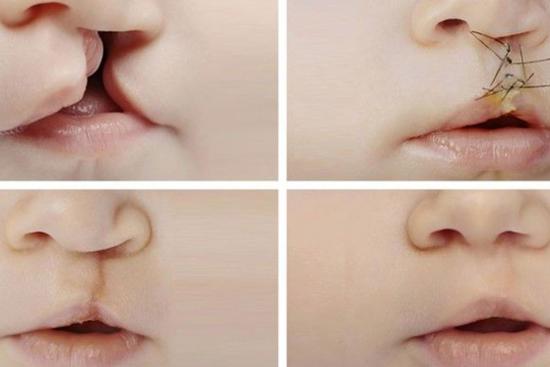A cleft lip is a congenital anomaly that occurs when the upper lip and palate fail to develop properly during the initial months of pregnancy.
Children born with this condition may face challenges in eating and speaking, along with the potential for ear infections, hearing loss, and dental issues.
Opting for a surgery of a cleft lip nasal deformity in Turkey allows individuals to benefit from the expertise and competitive pricing offered by experienced surgeons
Newborn children with cleft lips
About 1 hour and 30 minutes
A post-surgical follow-up of 4 to 6 months
Cleft lip surgery cost in Istanbul, Turkey
Prices of cleft lip nasal deformity surgery in Istanbul, Turkey in babies are highly variable, as it will depend on whether the child has cleft lip, cleft palate, or both abnormalities.
Turquie santé recommends the most experienced surgeons with affordable cost in Istanbul, Turkey.
Best Clinics with Verified Reviews

- Multispecialized hospital
- 7 operating rooms
- Capacity é of 170 beds

- Multispecialized hospital
- Hospital founded in 2007
- Very good reputation in ENT department
Cleft lip surgery in Istanbul, Turkey
A cleft lip occurs when the tissues that make up the upper lip and palate do not fuse properly before birth, leaving an opening in the upper lip. The size of this opening can vary from a small gap to one that extends from the lip to the nose. It can occur on either side of the lip or, less commonly, in the middle.
The objective of cleft lip and palate surgery is to achieve a beautiful and natural shape of the nose and lips without the presence of visible scars on the children's faces and to achieve perfect speech.
Surgical correction of a cleft lip, in Istanbul, Turkey, is usually performed within the first few months of a baby's life, usually starting around the third month. On the other hand, palatoplasty, or repair of the palate, is usually done around the ninth month. This surgery consists of closing the labial defect to repair all its structures (skin, mucosa, red lip, muscle) with the most hidden scar possible.

What causes this distortion?
The cause of cleft lip is not known for sure. What we do know is that the appearance of this anomaly is linked to genetic factors from both parents and environmental factors that specialists and scientists do not fully understand.
A small percentage of cases have a family history, but in most children, it appears in isolation and is not associated with other syndromes.
Cleft lip problems
The possible complications associated with a cleft lip nasal deformity surgery go beyond a simple aesthetic deformity such as:
Feeding problems: The baby will have difficulty or may be unable to suckle properly because the palate is not properly formed.
Luckily, there are specially designed bottles and teats to help babies suck and push liquids into their stomachs. Additionally, children with a cleft lip may need to wear an artificial palate to help them eat properly and ensure they receive adequate nutrition until they have surgery.
Speech problems: Due to the opening of the palate and lips, muscle function may be reduced, causing speech to be delayed or affecting normal speech.
Dental issues: These abnormalities can prevent teeth from coming out normally, in most cases requiring orthodontics.
Postoperative results
Following the surgery, the child may display some mild irritability. Additionally, the stitches will either dissolve naturally within a few days or will be removed within 5–7 days.
Rest assured, your doctor will give you detailed instructions on how to feed your child during the recovery period. An intravenous catheter will be used during and after surgery to provide fluids until your child is able to drink independently.
It's common for your child to feel some discomfort during the first two days after the procedure. This can be relieved with appropriate medication. As a reminder, make sure the medication does not contain aspirin. Your child's well-being is our top priority.
Share this page
To avoid the appearance of a cleft palate from the birth of the baby, it is strictly forbidden for pregnant women to smoke or drink alcohol. However, it is highly recommended to take folic acid-based supplements and to eat foods rich in this vitamin, such as spinach, liver, etc.
From the 22ᵉ week of pregnancy and following an ultrasound, the gynecologist can detect a cleft lip. However, any treatment must be taken after birth and parents must be aware of the malformation to know how to deal with the situation.
To feed a baby with a cleft palate, it is recommended to get him/her used to eat with a spoon to facilitate the postoperative feeding procedure.
Yes, the management of cleft lip is done from birth until the end of growth and involves primary and even secondary surgical and plastic intervention. A multidisciplinary team ensures the operation and the follow-up of the patient, as well as the management of morphological and functional disorders that may appear depending on age.
Yes, other than the morphological consequences, cleft lip and palate can have a significant impact on the child's psychology, either during early childhood or even afterward, which requires an aesthetic intervention as well as psychological support by experts.






